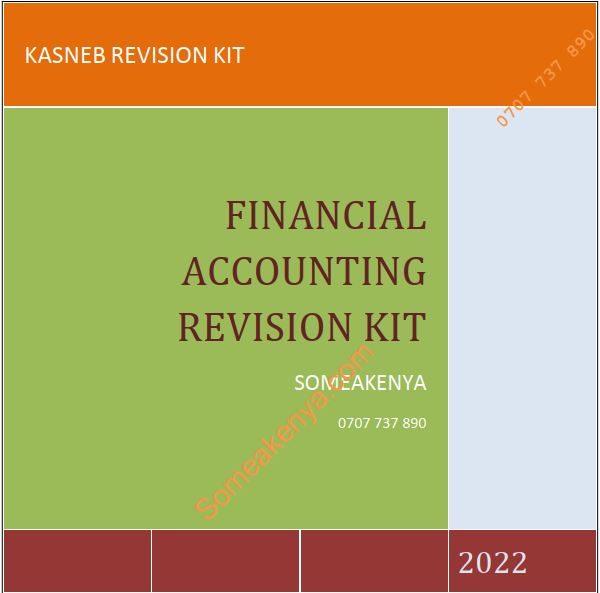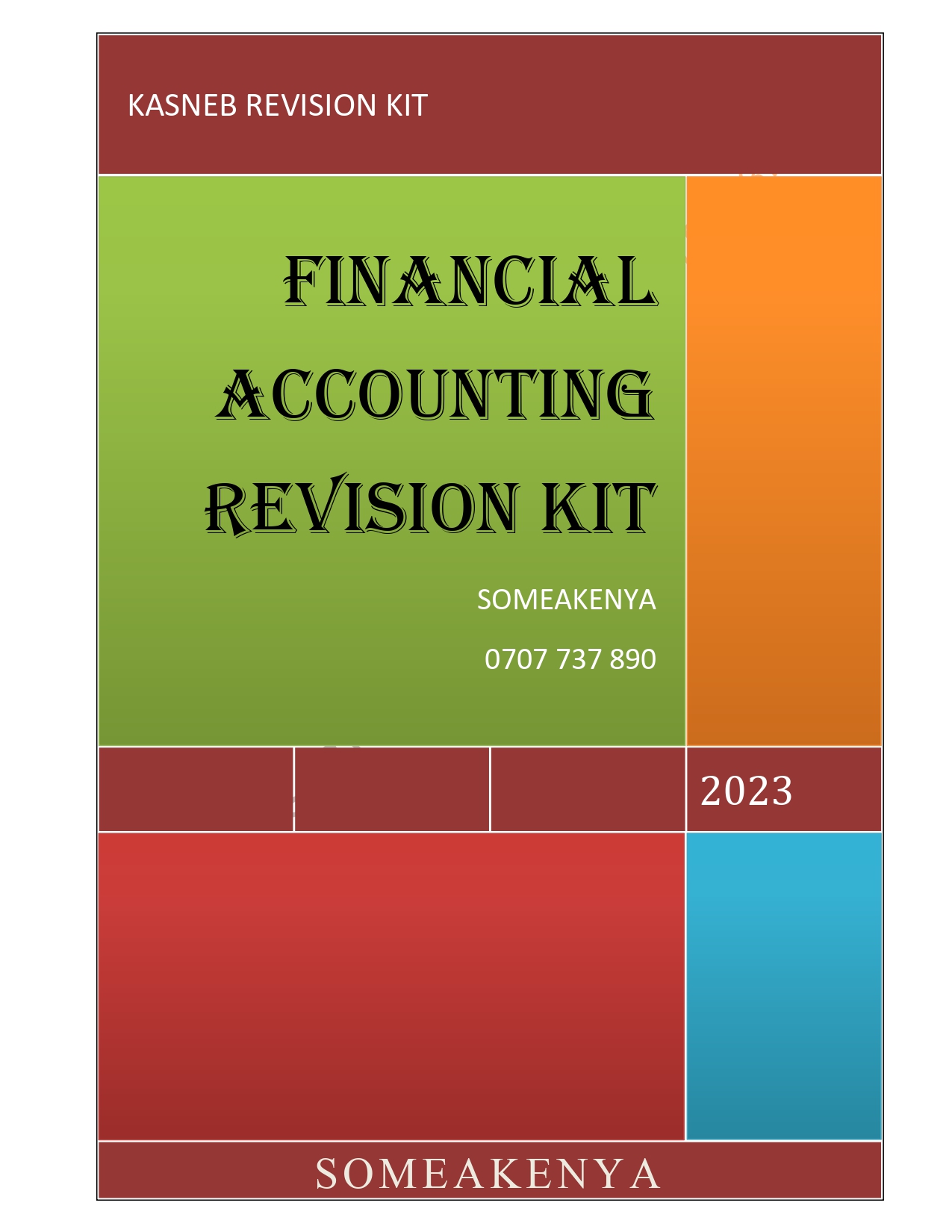
Past papers exam questions and answers
Revision is more than memorising facts and going over notes. You can practise an exam by answering CPA kasneb past exam questions from past papers. This will give you a better chance of passing.
By practising with real past examination papers you will:
- Find out if you have learnt enough to tackle CPA kasneb exams
- Identify any weakness that you may have in answering questions
- Learn about how the exam questions are answered.
Once you have completed a paper, you can compare your answers against the marking scheme. With the many past papers provided in our revision kits you will increase your chance of passing the upcoming exams.
Financial Accounting Revision Kit – Past exam questions and answers for kasneb CPA course
This revision kit consists of kasneb past paper questions and their suggested answers to act as a revision guide for those students taking kasneb courses.
Full Access to these notes/Kit on Desktop/Laptop via https://desktop.someakenya.co.ke
Or through Our Mobile App






Full Access to these notes/Kit on Desktop/Laptop via https://desktop.someakenya.co.ke
Or through Our Mobile App
TOPICS
- Topic 1: Introduction to Accounting – View Questions
- Topic 2: The Accounting Process and Systems – View Questions
- Topic 3: Regulation and other Principles guiding the Accounting Profession – View Questions
- Topic 4: Accounting for assets and liabilities – View Questions
- Topic 5: Financial statements of a sole trader – View Questions
- Topic 6: Financial statements of a partnership – View Questions
- Topic 7: Financial statements of a company – View Questions
- Topic 8: Financial statements of a manufacturing entity – View Questions
- Topic 9: Financial statements of a not-for-profit organisation – View Questions
- Topic 10: Correction of errors and Preparing Financial Statements with incomplete records – View Questions
- Topic 11: Analysing financial statements – View Questions
- Topic 12: Accounting in Public Sector – View Questions
PAPER NO. 1 FINANCIAL ACCOUNTING
UNIT DESCRIPTION
This paper is intended to introduce the candidate to the overall purpose of accounting, applicable regulations, the accounting treatment and presentation of basic transactions and preparation and analysis of financial statements.
LEARNING OUTCOMES
A candidate who passes this paper should be able to:
• Prepare books of original entry and basic ledger accounts under the double entry system
• Prepare basic financial statements of sole traders, partnerships, companies, manufacturing entities and not for profit organisations
• Comply with the regulatory framework in the accounting field
• Analyse financial statements by use of ratios and statement of cash flows
• Demonstrate basic understanding of public sector accounting framework
CONTENT
1. Introduction to Accounting
• Nature and Purpose of Accounting
• The objective of Financial Accounting
• The Elements of Financial Statements
• The Accounting Equation
• The Users of Accounting Information
2. The Accounting Process and Systems
• The Source documents such as receipts and invoices
• The Books of Prime entry/Original Entry from the journals, cashbooks, Petty cash books and registers
• The Ledger and the concept of double entry
• The Trial Balance
• The Financial Statements
3. Regulation and other principles guiding the accounting profession
• The legal sources of regulation
• The professional sources of regulation (local and international bodies) and ethical requirements
• Accounting Standards
• Common accounting principles/concepts
• Qualities of useful financial information
4. Accounting for Assets and Liabilities
• Property, Plant and Equipment (depreciation, acquisition, disposal, exchange, excluding revaluations)
• Intangible Assets
• Financial Assets and Financial Liabilities (Definition, Examples and Classification only)
• Inventory
• Cash in hand and cash at bank (bank reconciliation statements)
• Trade Receivables (Measurement and credit Losses)
• Trade payables
• Accrued Incomes/Expenses and Prepaid Incomes/Expenses
5. Financial Statements of a sole trader
• Statement of Profit or Loss
• Statement of Financial Position
6. Financial Statements of a partnership
• The partnership deed/agreement
• The statement of Profit or Loss and appropriation
• Partners’ capital and current accounts
• The statement of financial position
• Accounting treatment and presentation when there is a change in profit/loss sharing ratio, admission/retirement of a partner, dissolution of a partnership
7. Financial Statements of a company
• Important concepts of a company (Ordinary and Preference share capital, issuing new shares by way of full market price, bonus shares and rights issue, Reserves, retained profits and corporation tax)
• Statement of Profit or Loss
• Other comprehensive incomes
• Statement of Financial Position
• Statement of Cash flows
8. Financial Statements of a manufacturing entity
• Manufacturing Statement of production
• Statement of Profit or Loss
• Statement of Financial Position
9. Statements of a not-for-profit entity
• Objectives of Not-for-profit organisations
• Statement of Income and Expenditure
• Statement of Financial Position
10. Correction of errors and preparing financial statements with incomplete records
• Types and causes of errors
• Correcting errors in source documents, the books of prime entry, the ledger, the trial balance and financial statements
• Reasons for incomplete information
• Preparation of financial statements from incomplete information
11. Analyzing Financial Statements
• The objective of analysing financial statements
• Analysing financial statements using financial ratios (Liquidity, Profitability, Solvency, Efficiency, Investor/Value and Cash Flow categories)
12. Accounting in the Public Sector
• Features of public sector entities (as compared to private sector)
• Structure of the public sector (National and county governments, State Corporations, Departments and Agencies)
• Regulation and oversight (International Public Sector Accounting Standards Board, Director of Accounting Services, National Treasury, Parliamentary Committees, Accounting Officers at national and county levels)
• Objectives of public sector financial statements and Standards (IPSAS)
• Accounting techniques in public sector such as budgeting, cash, accrual, commitment and fund accounting)